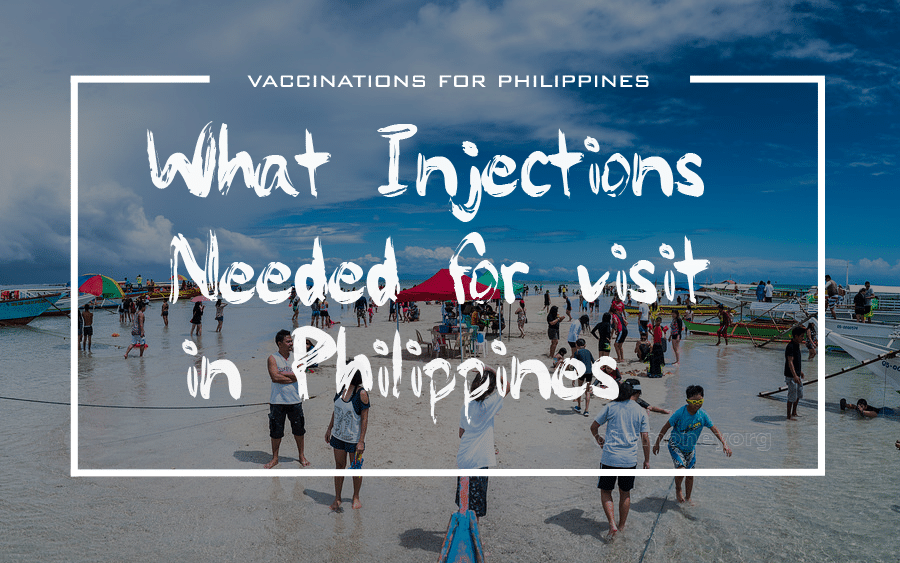
When planning a holiday getaway in a tropical country, like the Philippines, getting vaccination shots probably does not even make it into the preparation list. This seemingly insignificant measurement actually holds the final call to an awesome holiday or sick, gloomy day(s). If you want to take the precautions, below are the suggested vaccines for the common diseases in the Philippines:
1. Dengue
In a tropical, highly populated country like the Philippines, mosquitos are everywhere, even in bars and fancy restaurants. As CDC has stated, everyone is vulnerable to the disease, no matter where they stay and eat. Preparing yourself by bringing mosquito spray and lotion as well as getting rid of its possible nesting place (a container with stagnant water in it) can help reduce the likelihood of the tiny animal attack. However, it is best to get a shot before visiting the country, especially if your visit should take place during its rainy season or may involve hiking or exploring its wild zones.
Having the highest rate of dengue fever in 2015 and 2016 among other Asian countries with more than 200,000 cases, dengue is one of the country’s diseases to be taken seriously.
2. Hepatitis A & B
Culinary adventure is hard to miss when you are visiting the Philippines. The local foods look, smell and taste good. Although some dishes might look repulsive (balut, for example), most are actually tasty, if not addictive. The truth is that those yummy local foods tend to be found in local market, where hygiene is not the top priority. The food may be touched with bare hands, which may not be handwashed as frequently as they should be. The food and water are likely to be contaminated, too, due to unsanitary conditions in their local market. Avoiding food that may be taken out from sewage water like shellfish is also advisable.
So far, based on a recent research on hepatitis cases in the country, one out of seven local adults is infected. The risk of being exposed to this liver infection is higher if you are planning on getting a tattoo or anything in which needles and piercing are involved. The danger of this disease transmission also increases should sex be a part of your holiday plan.
While the symptoms of the diseases (abdominal pain, fever, nausea, fatigue, etc) may not look lethal, getting vaccinations for hepatitis A & B is crucial. Why? Because they can develop to chronic stage, in which a liver transplant may be needed to survive.
3. Rabies
Although commonly known to immunize people from infected dogs’ bites, this vaccine actually works for other animals’ bites. The Philippines is home to various exotic fauna and during your visit, there is always a chance that you will be bitten by one of them. The probability is even higher for those who fancy being outdoors doing adventurous stuff, like mountain climbing, camping, etc. Children are the ones that should be most protected by the vaccine as they have the tendency to be bitten on the head or neck and not to report the animal bite(s).
4. Typhoid
High fever and gastrointestinal problems, like diarrhea and vomitting, are the symptoms of typhoid. Quite similar to hepatitis, contaminated food and water pass on the disease. Enjoying the country’s local dishes without getting this vaccination is dangerous. It has been reported that there are around 21,5 million people worldwide infected by Salmonella typhi, the bacteria causing the infection. One fourth of the number end in fatalities.
5. Japanese Encephalitis
Endemic to tropical and sub-tropical countries, this disease has been declared fatal in three out of ten cases. As of January to August last year, fifty seven cases were reported in the Philippines.
The virus is transmitted by mosquitos known as Culex Tritaeniorhynchus. In most cases, those who are infected experience mild symptoms, while a small percentage show sudden headache, fever, seizures, disorientation and even coma, which are the symptoms of brain inflammation or encephalitis. Currently known as one of the incurable diseases, vaccination offers the best protection.
6. Yellow fever
Spread by mosquitos in what commonly known as densely populated areas, the disease is vulnerable to those who are not in fit conditions. Although the disease is originally found in Africa, South and Central America, global mobilisation has caused international alert. This may be due to the fact that the drug to counter this virus is not yet available, leaving no other better options but to get vaccined for yellow fever. Even many countries including the Philippines ask for this vaccination proof from those who come from countries endemic to yellow fever before issuing visa.
7. Malaria
When traveling in the Philippines, you should avoid mosquito bites to prevent malaria. You may need to take prescription medicine before, during, and after your trip to prevent malaria, depending on your travel plans, such as where you are going, when you are traveling, and if you are spending a lot of time outdoors or sleeping outside.
Conclusion
The Vaccinations and Medications that are needed for travel vary from person-to-person. Everyone should have a personal risk assessment with a travel health professional to take into account a range of factors such as itinerary, medical condition, occupational and lifestyle risk factors and previous vaccination history. Please visit your doctor (ideally, 4-6 weeks) before your trip to get vaccines or medicines you may need.
Leave a Reply